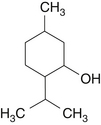Chapter 105 Mentha piperita (Peppermint)
Mentha piperita (family: Labitae)
 General Description
General Description
Peppermint is a natural hybrid of garden spearmint (Mentha spicata) and water mint (Mentha aquatica). First described in England in 1696, peppermint now grows all over the world.1 The two most popular varieties are white peppermint (Mentha piperita var. officinalis) and black peppermint (M. piperita var. vulgaris). Both are typical members of the mint family, that is, herbs with square stems, horizontal rhizomes, and lanceolated leaves with a serrated edge. Black peppermint has deep red stems with purplish-tinged dark green leaves, whereas white peppermint has green stems with lighter green leaves. Both varieties produce purple flowers during the summer months. For medicinal effects, the aerial portion of the plant is the most widely used.
 Chemical Composition
Chemical Composition
The major medicinal component of peppermint is its volatile oil, which can be found in concentrations of up to 1.5% in the herb, but is usually present in the range of 0.3% to 0.4%. The principal components of the oil are menthol (28% to 29%) (Figure 105-1), menthone (20% to 31%), and menthyl acetate (3% to 10%), although gas chromatographic analysis of peppermint oil typically shows more than 40 different peaks. Most of the volatile oil components are terpenoids.1
The composition of menthol and other volatile oil components is sensitive to climate and latitude as well as to the maturity of the plant. Pharmaceutic grade peppermint oil is produced by distilling the fresh aerial parts of the plant harvested at the very beginning of the flowering cycle. The oil is standardized to contain no less than 44% free menthol and a minimum of 5% esters calculated as menthyl acetate. The ketone component (calculated as menthone) usually ranges from 15% to 30%, with the remainder of the oil being composed of various terpenoids.1 Menthol is also synthesized by hydrogenation of thymol.
Other components of peppermint herb that may contribute to its medicinal effects are polymerized polyphenols (19% of dry weight), flavonoids (12%), tocopherols, carotenes, betaine, and choline.2
 History and Folk Use
History and Folk Use
Although peppermint was not officially recognized until the seventeenth century, mints have been used for their medicinal effects for thousands of years. Records from the ancient Egyptian, Greek, and Roman eras show that other members of the mint family, particularly spearmint (M. spicata), were used.1
 Pharmacology
Pharmacology
Carminative Effects
Carminatives promote the elimination of intestinal gas. Peppermint and peppermint oil are well-accepted carminatives. Although the exact mechanism of action has not been determined, one proposed mechanism is relaxation of the esophageal sphincter, which leads to the release of gas pressure in the stomach.3
Antispasmodic Effects
The mechanism behind peppermint oil’s antispasmodic effects was determined. Researchers concluded that peppermint oil inhibits contractions of isolated smooth muscles by blocking the influx of calcium into the muscle cells.4,5 Researchers hypothesized that the clinical effectiveness of peppermint oil in the treatment of irritable bowel syndrome (IBS) is a result of inhibition of the hypercontractility of intestinal smooth muscle, thereby returning the muscle to its proper tone.
Choleretic Effects
Choleretics stimulate the flow of bile. Menthol and related terpenes were shown to exert a choleretic effect as well as to improve the solubility of the bile.6–10




